| |
 |
A1-53167 |
 |
 |
 |
From an interview with Pat Binder and Gerhard Haupt.

In Guatemala, the military is currently being indicted for the massacres and crimes it has committed against humanity. Well known, for example, are the charges made by Rigoberta Menchú in England and Spain.

Last year, I organized an art action in which I scattered the contents of ten large sacks of coal across the main boulevard in the center of Guatemala City, on which a military parade was to take place. Unfortunately, the photo documentation that I have from this day is not very good, because there was great fear and paranoia. Altogether there are 180 photos, but I am only showing 25 or 26 here at the Biennale. The idea of this action is to remind the military of the many crimes it has committed. There is a close relationship namely, between the coal, the massacres, and the military, because this material can always be found in the mass graves. In most cases, houses and corpses are burned.

I knew that the coal would be cleared away before the parade. I scattered it at about two o'clock in the morning, and at seven o'clock it had already been removed. But there were still traces left. I wanted the military to walk over these traces, and to be able to take photos of the marching army. Since I work with signs that have somehow established themselves, in this case the coal that points to the massacres and the mass graves, I refer with the action to existing problems, without becoming too obvious. It wasn't my intention for the spectators to perceive these signs, but rather that the military itself should notice them.

In a few of the photos one can also see the »Kaibiles«, an elite force which, as far as I know, is meant to be the second most bloodthirsty in the world. They are supposed to have fought in Iraq, for example, and in other wars. The training for the Kaibiles is very hard. People say that they are dropped in the middle of the jungle in Petén, without food and only in the company of a dog, with the orders to reach a certain meeting point. If they make it there with the help of the dog, they have to eat it. It's horrible, and there are thousands of stories which one doesn't know if they're true or only legends. Truth is, however, that these troops were substantially involved in the operations against the guerillas. The name »kaibil« appears in the Popul Vuh, the sacred book of the Mayans, which by the way, is the ethnic group from which the Kaibiles have killed the most people. *)

The military has informants in the political parties and in the government, they meddle in everything, but they don't know anything about me. I can plan an action like this and they don't know where it comes from, because I prepare it carefully and carry it out as a surprise. But the fact is, I was unable to photograph a few scenes out of fear.

I don't think it's advisable to show these photos in Guatemala. Not so much because of me, as there are many institutions that support me, but rather because of the people that help me. I think it would be too dangerous... Maybe in the future, but that doesn't really make much sense because it's not the intent of the work. The goal in this case, for example, is for the military itself to notice something. The documentation of the action only serves to sell the photos overseas, in order to finance further actions of this kind. I'm not interested in creating pieces for galleries, but for a specific audience and a particular purpose. I prefer to provoke phenomena in order to cause specific experiences for my target audience, experiences which could lead to reflection and action.(Translated from the German version by Holly Austin) 
Note:
On December 5, 1974, Guatemala's military government created the Commando School (Escuela de
Comandos). Three months later, on March 5, 1975, it renamed it Kaibil Center for Training and Special Operations (Centro de Adiestramiento y Operaciones Especiales Kaibil). The name Kaibil is derived from Kaibil Balam, a Mam indigenous leader who evaded capture by the Spanish conquistadores.
Information from: »The Americas Project. Democracy and Human Rights in Guatemala«, World Policy Institute (New York). |
 |
+ zoom: click on images
 |
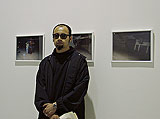

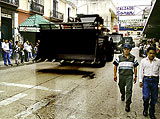

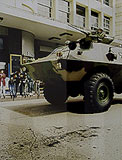

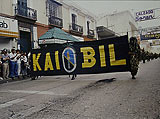

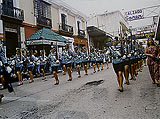

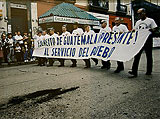 |
 |
 |
 |
| © |
 |
Interview, translation, reproductions:
Gerhard Haupt & Pat Binder |
|
|
|